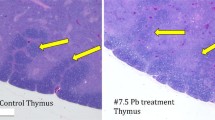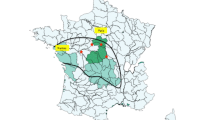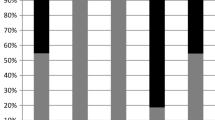Abstract
The effects of PCBs (polychlorinated biphenyls) or a combination of DDT (1,1,1-trichloro-2,2-bis (p-chlorophenyl) ethane), DDD (1,1-dichloro-2,2-bis (p-chlorophenyl) ethane) and DDE (1,1-dichloro-2,2-bis (p-chlorophenyl ethylene) on organ weights, liver storage of vitamin A and carotene, selected blood chemistry parameters, and serum protein fractions were determined in penned white pelicans (Pelecanus erythrorhynchos) receiving a daily dosage of these compounds. Birds received 100 mg of PCBs or a combination of DDT (20 mg), DDD (15 mg), and DDE (15 mg) injected into the first fish fed each day for ten weeks. A greater percentage of PCB treatment was retained in brain, liver, carcass and feathers than the percentage of DDT + DDD + DDE treatment. Liver weight as percent of body weight decreased (p<0.01) in DDT + DDD + DDE-treated birds and increased (p<0.01) as a total weight in PCB-treated birds. Spleen weight as percent of body weight was greater (p<0.05) in PCB-treated birds. Neither treatment had a significant effect on the weight of the brain, heart, or kidney. Liver vitamin A levels were greater (p<0.01) on a μg/g of liver basis in the DDT-treated birds than in controls. Significant lowering of serum potassium and protein values was noted in both the PCB- and the combination of DDT, DDD, DDE-treated birds, while serum calcium values were lowered (p<0.01) only in PCB-treated birds. Values of serum inorganic phosphorus, uric acid and magnesium were not significantly changed by either treatment. Globulin fractions were unaltered by either treatment, but albumin fractions were lowered (p<0.01) in the PCB-treated pelicans.
Similar content being viewed by others
References
Anderson, D. W., and J. J. Hickey: Eggshell changes in certain North American birds. Proc. XV Int. Ornith. Cong., p. 514 (1972).
Bailey, S., and P. J. Bunyan: Interpretation of persistence and effects of polychlorinated biphenyls in birds. Nature236, 34 (1972).
Bailey, S., P. J. Bunyan, B. D. Rennison, and A. Taylor: The metabolism of 1,1-di(p-chlorophenyl)-2,2,2-trichloroethane and 1,1-di(p-chlorophenyl)-2,2-dichloroethane in the pigeon. Toxicol. Appl. Pharmacol.14, 13 (1969a).
Bailey, S., P. J. Bunyan, B. D. Rennison, and A. Taylor: The metabolism of 1,1-di(p-chlorophenyl)-2,2-dichloroethylene and 1,1-di(p-chlorophenyl)-2-chloroethylene in the pigeon. Toxicol. Appl. Pharmacol.14, 23 (1969b).
Bell, D. J., and P. D. Sturkie: Chemical constituents of blood. In: Avian Physiology, 2 ed., Ithaca, New York: Comstock Pub. Assoc., Cornell Univ. Press (1965).
Bitman, J., H. C. Cecil, and S. J. Harris: Biological effects of polychlorinated biphenyls in rats and quail. Environ. Health Persp. Exptl. Issue No.1, 145 (1972).
Boyd, E. M., and C. P. Chen: Lindane toxicity and protein-deficient diet. Arch. Environ. Health17, 156 (1968).
Call, D. J., and J. K. J. Call: Blood chemistries of Japanese quail fed dieldrin. Poultry Sci.53, 54 (1974).
Dahlgren, R. B., R. L. Linder, and C. W. Carlson: Polychlorinated biphenyls: Their effects on penned pheasants. Environ. Health Persp. Exptl. Issue No.1, 89 (1972).
Ernst, R. A.: The physiological effects of selected pesticides on the Japanese quail (Coturnix coturnix japonica) and embryo-genesis of the domestic fowl. Ph.D. dissertation, Michigan State University, 86 pp. (1966).
Flick, D. F., R. G. O'Dell, and V. A. Childs: Studies of the chick edema disease. 3. Similarity of symptoms produced by feeding polychlorinated biphenyls. Poultry Sci.44, 1460 (1965).
Fowler, B. A.: The morphologic effects of dieldrin and methyl mercuric chloride on pars recta segments of rat kidney proximal tubules. Amer. J. Path.69, 163 (1972).
Greenwood, R., Y. A. Greichus, and E. Hugghins: Insecticide residues in big game mammals of South Dakota. J. Wildl. Mgmt.31, 288 (1967).
Greichus, Y. A., A. Greichus, and R. J. Emerick: Insecticides, polychlorinated biphenyls and merculy in wild cormorants, pelicans, their eggs, food and environment. Bull. Environ. Contamin. Toxicol.9, 321 (1973).
Greichus, Y. A., A. Greichus, and E. G. Reider: Insecticide residues in grouse and pheasant of South Dakota. Pesticides Monit. J.2, 90 (1968a).
Greichus, Y. A., and M. R. Hannon: Distribution and biochemical effects of DDT, DDD and DDE in penned double-crested cormorants. Toxicol. Appl. Pharmacol.26, 483 (1973).
Greichus, Y. A., D. Lamb, and G. Garrett: Efficiency of extraction of metabolically incorporated HEOD (carbon-14) from pheasant tissues, eggs and faeces. Analyst93, 323 (1968b).
Hannon, M. R., Y. A. Greichus, R. L. Applegate, and A. C. Fox: Ecological distribution of pesticides in Lake Poinsett, South Dakota. Trans. Amer. Fish. Soc.99, 496 (1970).
Holmes, D. C., J. H. Simmons, and J. O'G. Tatton: Chlorinated hydrocarbons in British wildlife. Nature216, 227 (1967).
Moore, G. L., Y. A. Greichus, and E. J. Hugghins: Insecticide residues in pronghorn antelope of South Dakota. Bull. Environ. Contamin. Toxicol.3, 269 (1968).
Platonow, N. S., and H. S. Funnell: The distribution and some effects of polychlorinated biphenyls (Aroclor 1254) in cockerels during prolonged feeding trials. Can. J. Comp. Med.36, 89 (1972).
Presst, I., D. J. Jefferies, and N. W. Moore: Polychlorinated biphenyls in wild birds in Britain and their avian toxicity. Environ. Pollut.1, 3 (1970).
Rehfeld, B. M., R. L. M. Bradley, Jr., and M. L. Sunde: Toxicity studies on polychlorinated biphenyls in the chick. 2. Biochemical effects and accumulations. Poultry Sci.51, 488 (1972).
Siller, W. G.: Avian nephritis and visceral gout. Lab. Investig.8, 1319 (1959).
Steel, R. G. D., and J. H. Torrie: Principles and Procedures of Statistics. New York, N.Y.: McGraw-Hill Book Company, Inc. (1960).
Stemp, A. R., B. J. Liska, B. D. Langlois, and W. J. Stadelman: Analysis of egg yolk and poultry tissues for chlorinated insecticide residues. Poultry Sci.43, 273 (1964).
Stickel, L. F., W. H. Stickel, and R. Christensen: Residues of DDT in brains and bodies of birds that died on dosage and in survivors. Science151, 1549 (1966).
Tasker, J. B.: Fluids, electrolytes and acid-base balance. In C. E. Cornelius and J. J. Kaneko, eds, Clinical Biochemistry of Domestic Animals. Vol. II, 2 ed., Academic Press, New York (1971).
Treon, J. F., F. P. Cleveland, and J. Cappel: Toxicity of endrin for laboratory animals. J. Agr. Food Chem.3, 842 (1955).
Vos, J. G., and J. H. Koeman: Comparative toxicologie study with polychlorinated biphenyls in chickens with special reference to porphyria, edema formation, liver necrosis, and tissue residues. Toxicol. Appl. Pharmacol.17, 656 (1970).
Vos, J. G., J. J. T. W. A. Strik, C. W. M. Van Holsteyn, and J. G. Pennings: Polychlorinated biphenyls as inducers of hepatic porphyria in Japanese quail, with special reference to α-amino-levulinic acid synthetase activity, fluorescence, and residues in the liver. Toxicol. Appl. Pharmacol.20, 232 (1971).
Walker, C. H., G. A. Hamilton, and R. B. Harrison: Organochlorine insecticide residues in wild birds in Britain. J. Sci. Food Agr.18, 123 (1967).
Walker, A. I. T., D. E. Stevenson, J. Robinson, E. Thorpe, and M. Roberts: The toxicology and pharmacodynamics of dieldrin (HEOD); Two-year oral exposure of rats and dogs. Toxicol. Appl. Pharmacol.15, 345 (1969).
Wassermann, M., D. Wassermann, E. Kedar, M. Djavaherian, S. Cucos, and S. Ventura: Effect of organochlorine compounds on serum proteins. Bull. Environ. Contamin. Toxicol.10, 42 (1973).
Woodwell, G. M., C. F. Wurster, Jr., and P. A. Isaacson: DDT residues in an East Coast estuary: A case of biological concentration of a persistent insecticide. Science156, 821 (1967).
Author information
Authors and Affiliations
Rights and permissions
About this article
Cite this article
Greichus, Y.A., Call, D.J., Ammann, B.M. et al. Physiological effects of polychlorinated biphenyls or a combination of DDT, DDD, and DDE in penned white pelicans. Arch. Environ. Contam. Toxicol. 3, 330–343 (1975). https://doi.org/10.1007/BF02220745
Received:
Accepted:
Issue Date:
DOI: https://doi.org/10.1007/BF02220745




